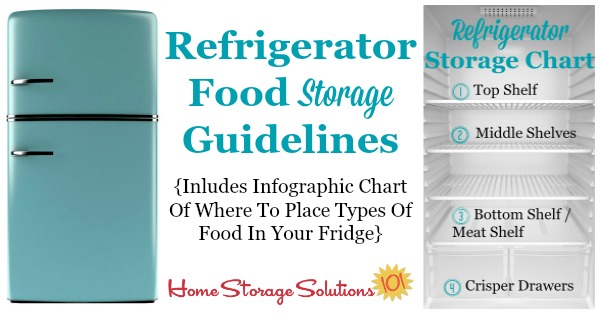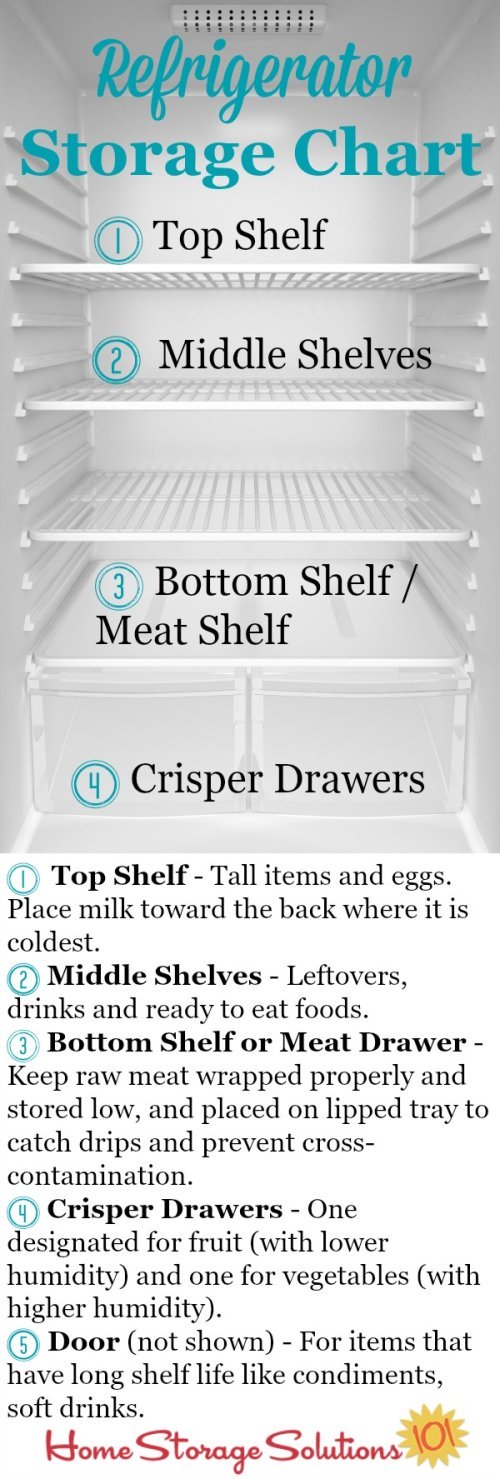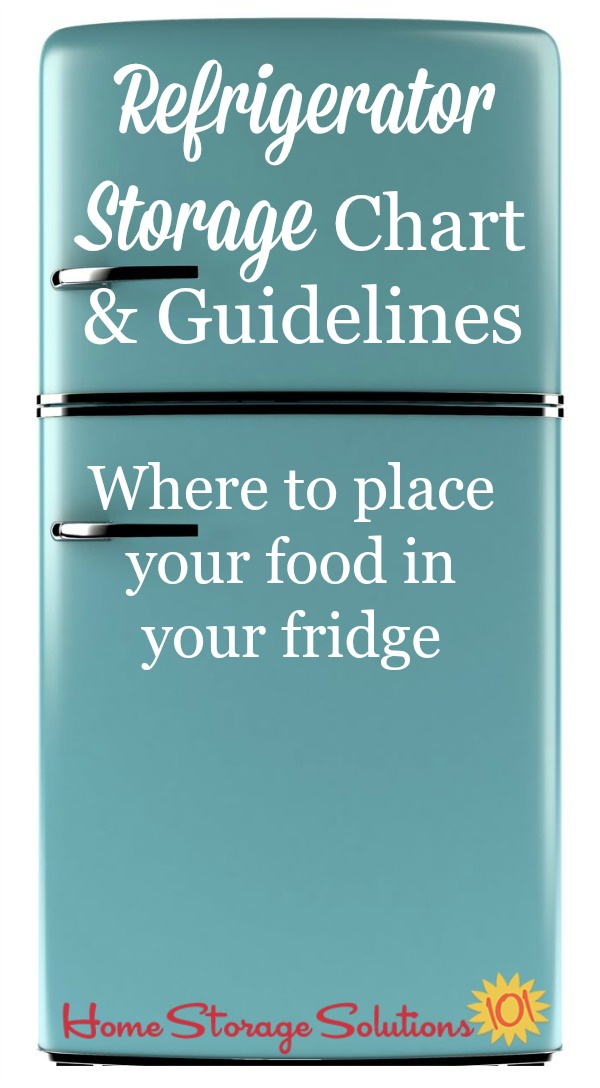
Refrigerator Storage Chart & Guidelines: Where To Place Your Food In Your Fridge
Find out where you should be placing various types of food in your fridge with this refrigerator storage chart and guidelines.

It's nice to have an organized refrigerator, but even more important is to have a refrigerator which keeps your foods at the correct temperature and humidity and in the right places to avoid cross-contamination and avoid spoilage.
Fortunately when you place items in your refrigerator in the way I've described below you can have both organization and keep food safety in mind!
Organize Your Refrigerator Like The Professionals Do
When deciding how you'll organize your fridge, think like a professional, such as a restaurant or chef.
That is because professionals are required to keep food safety in mind when they decide where to place various items, plus since they use items from their refrigerator for their cooking as part of their business, day and in and day out, they've considered functionality and convenience at the same time already.
They think of storage from top to bottom, with cooked foods and ready to eat foods toward the top, and raw foods that must be cooked toward the bottom.
In addition they confirm regularly that their refrigerator is properly cooling the items within it. As I mentioned in my food storage safety article your refrigerator should stay at or below 40° F.
One way to make sure your refrigerator keeps cooling as it should is not to overfill it, or to pack too many items into too tight of a space within it. When you keep it from being too tightly packed this allows sufficient air flow around the items which keeps them cool.
What To Keep On The Door
The door of your fridge is the area which experiences the most frequent fluctuations in temperature, each time you open this large appliance.
Because of that temperature variations, for food safety reasons, plus to prevent rapid spoilage, only keep items such as soft drinks and long shelf-life types of items there, such as condiments.
Although some refrigerator doors have spots for you to place your eggs, don't do it. Eggs should stay in their original packaging, and also will spoil more quickly if they experience the temperature variation from the door. Therefore, a better place for your eggs is on one of the upper shelves of your refrigerator.
What To Place On Upper Shelves
The upper shelves of your refrigerator are best suited for tall items as well as leftovers and ready to eat or drink items such as yogurt, cheese, and lunch meats. Basically stuff that has already been cooked or doesn't need to be cooked.
Not all refrigerators have the exact same layout, but if you can adjust shelves in your fridge do so, it will save you a lot of headaches when trying to fit taller items in certain locations.
In addition, make sure to put your milk, which should stay as cool as possible without freezing, farther back in the fridge, since the back is typically the coldest location of your fridge.
Storing Meat: Food Safety Rules Should Be Followed
As I mentioned above, keep already cooked or ready to eat items high, which means raw meats should be kept low. This is logical, since raw meats can drip and you don't want to contaminate your other food with raw meat juice.
Some refrigerators have their own meat drawer, while others do not. The meat drawer, if you have one, is typically set to be one of the coldest locations in the fridge to help prevent spoilage. Whether you use a drawer or the bottom shelf for your meat, make sure to clean the drawer or shelf frequently because you also don't want to have cross-contamination between various meats.
To help with this keep your meats packaged and sealed until use, including wrapped in plastic bags if possible, or at least place the meat, in its packing, on lipped trays to help catch any drips which may occur. This is especially important if your crisper drawers are lower than your meat shelf or drawer.
One common mistake when storing food in your refrigerator is to keep raw meats in a drawer with produce. This is a big no no. You need to keep these items separate from one another. If you prefer to use one of your crisper drawers, that I'll discuss more below, as a meat drawer since you don't have one otherwise, no problem. But designate it only for raw meats, not for both types of items.
Storing Fruits & Vegetables: Consider Humidity
Last, but definitely not least, consider how you're storing your produce. Most refrigerators have two crisper drawers, and they are actually not the same even if they visually look like they are. One of the drawers is designed to keep certain produce, typically fruits, at a lower humidity, while the drawer is designed to keep other produce, typically vegetables, at a higher humidity.
The short version of why humidity is important when storing your produce has to do with ethylene gas, which is a naturally occurring hormone of plants which triggers some produce to ripen. Too much of it though, for too long, and it will cause the produce to pass ripening and go to spoiling and rotting.
One of the simplest things you can do to keep your produce fresh longer is to make sure you're using your two crisper drawers properly, and separating out the produce that is sensitive to ethylene from the produce that is not.
Here's a simple list of some of the most common types of produce and whether it should go in the high or low humidity drawer. As you can see the lists are not perfectly aligned between fruits and vegetables, but many more vegetables go in the high humidity drawer while more fruits go in the low humidity drawer.
| High Humidity (a.k.a. Vegetable Drawer) | Low Humidity (a.k.a. Fruit Drawer) |
| Asparagus | Apples |
| Broccoli | Avocados |
| Carrots | Berries |
| Cauliflower | Citrus |
| Cucumbers | Grapes |
| Green beans | Green onions |
| Leafy greens | Kiwi |
| Lettuce | Melons |
| Peas | Mushrooms |
| Peppers | Nectarines and peaches |
| Spinach | Okra |
| Summer squash | Pears |
| Zucchini | Plums |
For a full explanation of the difference between the two crisper drawers, and which types of produce should go in each one, check out my friend Marybeth's blog post here.
You can also get even more information about tips for storing fresh fruit here and storing fresh vegetables here, in articles on this site (and both articles come with a free printable storage chart for the produce).
Refrigerator Food Storage Guide Infographic
To help illustrate where each type of item should be placed in a typical refrigerator I created this infographic to help you remember the guidelines listed above.

This simple refrigerator storage chart and guidelines will help you to keep your refrigerator organized while making sure the food stored there is safe for your family to enjoy eating.
This article is sponsored by the Indiana's Family of Farmers. All thoughts and opinions are my own.














Share Your Comments, Tips & Ideas
I would love to hear from you, sharing your thoughts, questions, or ideas about this topic, so leave me a comment below. I try to always respond back!